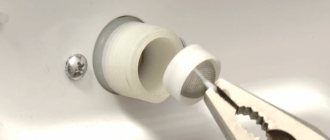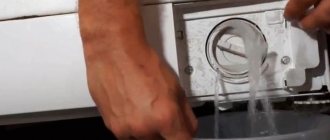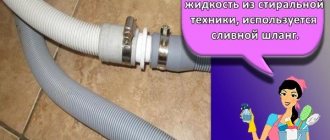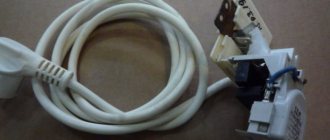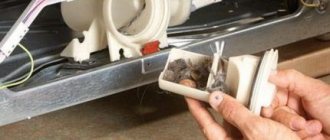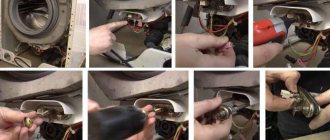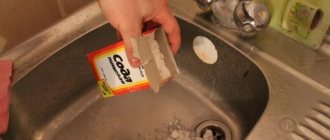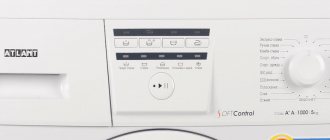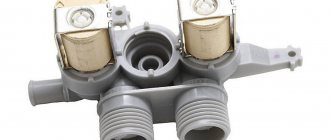When is cleaning necessary?
The filter needs to be cleaned as it gets dirty. Experts recommend performing this procedure for preventive purposes once every 2-3 months.
For Diamond series devices, you need to clean the filter at least 5-6 times a year. The more actively household appliances are used, the more often the procedure should be carried out .
Provided that an animal lives in the house, these deadlines are shifted. As practice shows, the filter needs to be cleaned after every 10-15 washing cycles.
If you ignore the advice, then one day the filter will clog. The machine will not be able to drain the water in the usual way and will have to carry out this procedure in emergency mode. In this case, the error code, 5C or will be displayed on the screen.
Error E2 is typical for those machines that were released before 2007 . Other codes appear on more modern models. Error 5E and E5 should not be confused. Code E5 indicates a malfunction in the water heating system, and not a clogged filter.
Not all Samsung washing machines are equipped with a screen. If it is not there, then a clogged filter will be indicated by a burning 40 degree indicator and flashing lights in all operating modes. If there is no error, but the part is clogged, the water after washing will drain more slowly than usual.
An unpleasant odor emanating from the washing machine may indicate that a blockage has formed. It becomes especially intense if the device is not used for several days.
How to wash the filter on a Samsung vending machine
It often happens that the drain filter, which is located at the bottom right under the panel, becomes clogged. The part itself looks like a plug with a special handle that must be unscrewed, then it should be pulled out of the hole and rinsed thoroughly, removing all dirt.
After all the procedures, the part must be inserted into place until it stops; it must fit tightly. If this is not monitored, there may be leaks in the future. It is recommended to perform such actions at least once a year.
Where is the filter element located?
The cleaner is located at the bottom of the Samsung washing machine. In devices with horizontal loading, it is located on the front wall, at the bottom right side.
The part is covered with a rectangular cover . If the machine was produced a long time ago, then the pump can be found under a removable plastic false panel.
In top-loading appliances, the filter can be found under the panel at the bottom, on one of the sides. However, such models are rarely found in Russian stores.
Selection rules
When choosing a filter, you should take into account the goals and quality of water used on the farm, and the financial capabilities of the consumer.
By purpose
Water quality is regulated by GOST 51232-98. Indicators of its rigidity are defined in SanPiN 2.1.4.1074–01. The latter states that the maximum mineral salts is 7 mEq/L.
Classifications of water by hardness:
- soft – less than 2°F;
- average – from 2 to 10°F;
- hard – more than 10°F.
The presence of iron and other components that affect hardness indicators can vary depending on the sources used to obtain it from the enterprises that purify it and supply it to consumers.
If the region has soft water, then purifiers are not required. There are enough additives found in washing powders. In this case, prefilters are installed for household appliances, and fine purification systems for drinking water. They will retain mechanical particles, rust, and microorganisms.
If scale forms in the kettle - this is already 4-5 °F - then it is advisable to install specialized cleaning systems for the washing machine. This can be a polyphosphate or prefilter.
If the water quality complies with GOST, but the hardness indicators are close to the maximum values, then it is recommended to install a device for rough cleaning at the entrance to the house, special filters for the washing machine and for drinking needs.
By equipment brand
One of the components of a washing machine, be it Samsung, Indesit, Bosch or others, is the water pump filter.
These parts vary depending on the manufacturer and model of the equipment.
Filters that are installed in water pipelines are universal devices. They purify water regardless of the model and manufacturer of the washing machine.
According to technical characteristics
According to technical characteristics, industrial and household filters are distinguished. A feature of the former is high productivity, which provides a large amount of purified water.
The second has a small throughput capacity, but is sufficient to purify water for domestic needs. For washing machines, flow filters with a capacity of 3000 to 5000 liters are used. The duration of their operation depends on the type of device.
For example , the thread filler of a prefilter will have to be changed once every 3 months, and the polyphosphate filler for water softening will have to be changed on average after 200–400 washes.
Examples of good choices
Let's look at 3 examples:
In areas with soft water from underground artesian wells, it is enough to install a prefilter from any manufacturer.- An area with water intake from surface sources , soft water - a pre-filter at the entrance of the water supply pipes to the house, a fine purification device for the drinking water tap.
- Areas with hard water, regardless of the source - a prefilter at the entrance of the water supply pipes to the house, a polyphosphate filter - to soften the water in the washing machine. If desired and financially possible, a reverse osmosis system for drinking water.
Preparing for cleaning
Before you begin the main procedure, you need to perform a number of preparatory steps:
- Turn off the water supply tap.
- Disconnect the device from the network. This is a mandatory condition to avoid electric shock.
- Prepare the tools needed for cleaning.
- Using a screwdriver, coin or knife with a rounded end, pry off the hatch cover that covers the part.
- Holding the protrusion on the filter, turn it counterclockwise 60 degrees and wait until the water drains out.
This completes the preparation. You can take out the part and start cleaning. The recess into which the filter is screwed is called a snail niche.
Instructions
By following the step-by-step instructions for cleaning the filter, you will be able to quickly cope with the task. Having successfully carried out this procedure once, it will not cause difficulties in the future.
What tools are needed?
To carry out the work you will need the following tools:
- old toothbrush;
- slotted screwdriver;
- pliers;
- a rag or container for collecting water;
- flashlight;
- tweezers or small scissors;
- citric acid and water.
Cleaning process
The cleaner is unscrewed using a rotational motion. You need to turn it counterclockwise. If cleaning is carried out in emergency mode, it is necessary to lay a rag to prevent water from spreading across the floor.
The procedure for cleaning the debris trap does not always go smoothly . When carrying out this procedure, you may encounter the fact that the part cannot be removed the first time. Most often this happens when it is rarely removed. Scale or foreign objects may prevent removal.
To avoid damaging the filter, gently tap the filter cover. If this does not help, use pliers. To avoid breaking the ledge, you need to control the pressure. Rotate them carefully, without sudden movements.
Another way to remove the filter from the niche is to remove the drain pump. However, this process is more labor-intensive and difficult to cope with on your own.
When the filter is in your hands, it must be rinsed under running water. It is recommended to use an old toothbrush to remove dirt and debris . If the hair and threads are very tangled in the mesh, you can use nail scissors and carefully trim them.
When the part is cleaned, there is no need to rush to return it to its place. You should take a flashlight and shine it into the hole from which it was removed. Having found the impeller of the drain pump, remove debris from it and remove wound hair and threads. To do this, you can use tweezers.
When the dirt is removed, put the filter back, twisting it clockwise. It must be screwed tightly . After completion of work, close the lid.
If there is a lot of scale and mold on the filter, you can remove it with citric acid. The part is soaked in a weakly concentrated solution for 2 hours. After this treatment, the mesh is washed with clean water.
Example for Samsung Diamond washing machine
Instructions are always more understandable if they are analyzed using a specific example . A step-by-step algorithm for dealing with emergency drainage is considered for the Samsung Diamond washing machine model:
- Open the hatch behind which the purifier is hidden.
- Remove the drain tube from the hook and pull it out.
- Remove the plug from the hose and drain the water.
- Install the plug and return the hose to its place.
- Proceed to clean the filter according to the instructions given above.
About washing machine filters
If low-quality water containing foreign impurities enters a house or apartment, it is recommended to equip washing equipment with filters. There are several types available, and even more manufacturers, so this article will provide recommendations for choosing.
Kinds
The differences between filters are the installation location and the functions they perform. Effective designs that have proven themselves in poor water conditions:
- mainline This device does not apply specifically to washing machines. Its action is of a general direction. The main filter purifies all water that enters the home. Such a powerful device is installed on the inlet water pipes. The function of this water purifier is to prevent foreign matter from entering the water. But it cannot affect the chemical composition in any way, so hard water will not become softer;
- deep cleaning. This device is designed specifically for washing equipment and is installed in front of the inlet hose. Its task is to retain rust, iron, sand and other substances that can penetrate into the water used for washing clothes. In this case, the filter does not affect the hardness of the liquid;
- polyphosphate. These water purifiers are the most popular. Sometimes there is another name for them - saline, since the flask contains a substance that looks like salt. The function of this device is to soften water. That substance, sodium polyphosphate, is consumable, so it will have to be changed from time to time. By loading the flask to the brim, this is enough for 10,000 liters of liquid. At the same time, the device is inexpensive and additionally protects the heating element of the washing machine from scale;
- magnetic. This device is also designed to soften water. This type of filter is not installed, but simply secured in front of the inlet hose. Magnetic purifiers have a beneficial effect on the chemical composition of water, making it softer. As a result, scale does not form on equipment parts.
Each filter has its own tasks, so they are often combined.
What is it needed for
Many washing machines already have an integrated coarse cleaning system. As a rule, it is located next to the drain hose.
It successfully copes with retaining large debris, but it is unable to remove small inclusions; for this, water purifiers are already purchased.
There are filters for washing machines, and there are devices for apartments that process all the water coming from the water supply.
Using a water filter is a reasonable expense. Although the device costs, sometimes impressively, it brings significant benefits - it extends the life of household appliances.
What does water filtration do:
- No foreign impurities get into the drum and other components of the washing machine. Without a filter, the “internal” cleaning system will quickly become clogged with dirt, which will lead to a decrease in pressure and water absorption capacity;
- Sand, rust and other elements are removed from the liquid. If you leave everything as is, the drain hose will clog prematurely, or even fail altogether;
- corrects water hardness.
The situation with bad water occurs in old houses where the water pipes have not been repaired for a long time. The liquid, passing through such pipes, “sucks in” harmful elements, which, accumulating in the components of the washing machine, lead to premature failure.
What problems might you encounter?
If a puddle of water forms on the floor after cleaning, this indicates the following problems:
- the part is not completely screwed in;
- during its installation, there was a misalignment in the threaded connection;
- The elastic band acting as a gasket was damaged.
The first two problems can be quickly resolved by reinstalling the filter. If the cause is hidden in a damaged seal, it must be replaced.
The worst thing is if the thread breaks when trying to remove the filter. In this case, you will need to replace the pump volute or the filter itself.
You will find all the most important and useful information about Samsung washing machines in this section of the site.
Disassembling and cleaning the filter
“Washing machine” is not a split system; its maintenance is less expensive. First you will need to clean the inlet filter. Procedure:
- Disconnect the machine and remove the power cord away from moisture.
- Close the shut-off valve.
- Disconnect the hose (water will come out of it, so be careful).
- Remove the mesh using pliers.
- The mesh must be washed under strong water pressure.
After washing and assembly, we proceed to the next test. Now you need to get the drainage device. Proceed like this:
- Open the front panel (a flathead screwdriver will be useful).
- Place the container under the black stopper.
- Unscrew the cap and drain the liquid (sometimes you may need to tilt the machine).
LE error on Samsung washing machine
After unscrewing the filter, it should be cleaned of accumulated debris. This is done by hand. Next, place it under running water.
If necessary, clean the mounting hole. After installing the part in its original place, fix the panel. If the drain block is stuck, you will have to remove the pump. To do this, you need to loosen the clamps and unscrew the screws, and only then disassemble the product.
